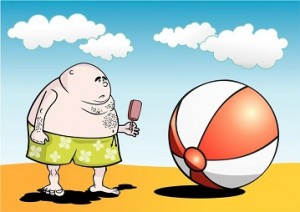By Nathan Parsons
 We still have a lot of Summer remaining and this can mean only one thing. Yes, it’s time to top up that tan. As a species we generally worship the sun. The feel good fact tor one gets by basking in the sunshine is probably better than any drug a doctor can prescribe. We all appreciate how good a tan looks on our bodies and therefore we take every opportunity to get one whether that be flying off to tropical climes or roasting on a tanning bed.
We still have a lot of Summer remaining and this can mean only one thing. Yes, it’s time to top up that tan. As a species we generally worship the sun. The feel good fact tor one gets by basking in the sunshine is probably better than any drug a doctor can prescribe. We all appreciate how good a tan looks on our bodies and therefore we take every opportunity to get one whether that be flying off to tropical climes or roasting on a tanning bed.
However, sunbathing is not without its risks which mean that most of us will require the use of sunscreen. So what does sunscreen do and why do we need it? Here we take a further look at the product and explore the various terms which appear on the bottle.
The sun constantly bombards us with UV rays. These are essentially electromagnetic radiation which comes from sunlight and are completely invisible. There are only two types of UV light which actually manage to penetrate the earth’s atmosphere, these being UVA and UVB. UVB is the type which generally causes our skin to darken whereas UVA has for a long time been associated with skin cancer. UVA in effect results in damage to our DNA and will over time cause ageing and wrinkling. It accounts for over 95% of all UV rays and is present all year round even in cloudy conditions. This is why it is important to use sunscreen. Sunscreen works by minimising the effects of the harmful UV rays. The chemicals which combine to make sunscreen can be organic or inorganic and they work by filtering the UV rays so that less of them reach the deeper layers of the skin. It doesn’t stop all the rays entirely but they are significantly reduced. Of course it is better to have this degree of protection rather than not at all.
You will see many different terms and phrases on the side of a bottle of sunscreen and most of us although familiar with them, don’t really know what they actually mean. We’ve seen what UVA and UVB refer to above but what does SPF mean? The SPF acronym is common to all bottles of sunscreen. SPF stands for simply ‘Sun protection factor’ The SPF denotes the ability of the product to block UVB rays which cause the skin to tan. They do not however block UVA rays.
 The SPF number is what we tend to use when purchasing a product. It can give a rough indication of how long we can stay out in the sun. Our bodies naturally contain a certain amount of sun protection depending on the pigmentation of our skin. For example a fair person might typically be able to stay out in the sun for no longer than 10 minutes without protection. If they were however to put on a sunscreen with an SPF of 10, then they would be able to stay out in the sun for approximately 100 minutes, i.e. 10 x 10.
The SPF number is what we tend to use when purchasing a product. It can give a rough indication of how long we can stay out in the sun. Our bodies naturally contain a certain amount of sun protection depending on the pigmentation of our skin. For example a fair person might typically be able to stay out in the sun for no longer than 10 minutes without protection. If they were however to put on a sunscreen with an SPF of 10, then they would be able to stay out in the sun for approximately 100 minutes, i.e. 10 x 10.
Another phrase you will see on the bottle is water resistant and/or waterproof. Water resistant generally means that the SPF protection will remain for a very limited period after exposure to water or sweating. Waterproof on the other hand means that the SPF will retain its properties up to 80 minutes after exposure to water which does include swimming.
Of course care should always be taken and one should never assume they are entirely free from burning just because sunscreen has been applied. As with anything else in life, common sense should always prevail!
– Nathan Parsons is a freelance writer and graphic designer based in London. Having graduated from the in ’96 and after working for various agencies, he decided to go freelance in 2009. He specialises in working closely with brands, companies and individuals in order to utilise a massive range of expertise that would otherwise be unavailable to the public. Nathan is currently producing a series of articles in partnership with SpaceNK.
